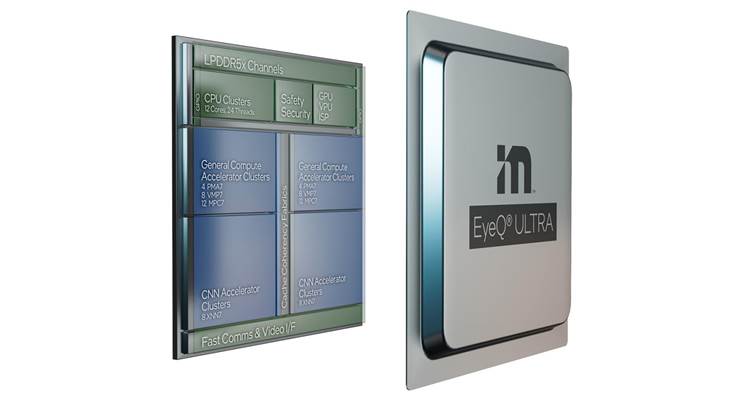Intel's Mobileye last week introduced the EyeQ Ultra, the company’s most advanced, highest performing system-on-chip (SoC) purpose-built for autonomous driving.
As unveiled during CES 2022, EyeQ Ultra maximizes both effectiveness and efficiency at only 176 TOPS, making it the industry’s leanest autonomous vehicle (AV) chip. This efficiently designed SoC builds on seven generations of proven EyeQ architecture to deliver exactly the power and performance needed for AVs, which are all but certain to be all-electric vehicles. First silicon for the EyeQ Ultra SoC is expected at the end of 2023, with full automotive-grade production in 2025.
Mobileye designed the EyeQ Ultra after having first built an AV to understand exactly what a self-driving vehicle needs to operate at a very high meantime between failures. This approach enables the optimum balance of performance across different accelerators and general-purpose processors in an extremely efficient power-performance envelope.
Marking a leap in the evolution of the EyeQ family of SoCs, EyeQ Ultra packs the performance of 10 EyeQ5s in a single package. Leveraging 5 nanometer process technology, EyeQ Ultra can handle all the needs and applications of Level 4 (L4) autonomous driving without the power consumption and costs related to integrating multiple SoCs together. Like its EyeQ predecessors, EyeQ Ultra has been engineered in tandem with Mobileye software, enabling extreme power efficiency with zero performance sacrifices.
EyeQ Ultra utilizes an array of four classes of proprietary accelerators, each built for a specific task. These accelerators are paired with additional CPU cores, ISPs and GPUs in a highly efficient solution capable of processing input from two sensing subsystems – one camera-only system and the other radar and lidar combined – as well as the vehicle’s central computing system, the high-definition map and driving policy software. At a mere 176 TOPS, the EyeQ Ultra is much more efficient than other AV solutions, delivering the necessary performance and price-point required for consumer-level AVs.
By optimizing for efficiency, EyeQ Ultra unlocks the AV potential for safer roads and reduced congestion for consumers.
Evolution of the EyeQ Architecture
The introduction of EyeQ Ultra comes at the same time as two new EyeQ SoCs for ADAS – the EyeQ6L and EyeQ6H – and follows the shipment of Mobileye’s 100 millionth EyeQ SoC late last year. First introduced in 2004, Mobileye’s EyeQ transformed the ADAS market by proving that cost-effective camera sensors processed by Mobileye’s purpose-built technology were capable of preventing and mitigating collisions. The innovation of EyeQ helped make roadway safety technology more accessible, bringing features including forward-collision warning, lane departure warning and blind spot detection to millions of drivers around the world.
Prof. Amnon Shashua, Mobileye president and chief executive officer
By developing the entire self-driving solution – from hardware and software to mapping and service models – Mobileye has a unique perspective into the exact requirements for the self-driving system that enables us to reach the performance-and-cost optimization that will make consumer AVs a reality.






















